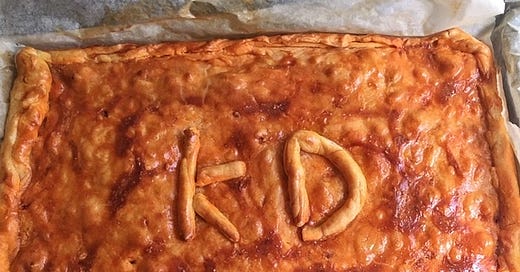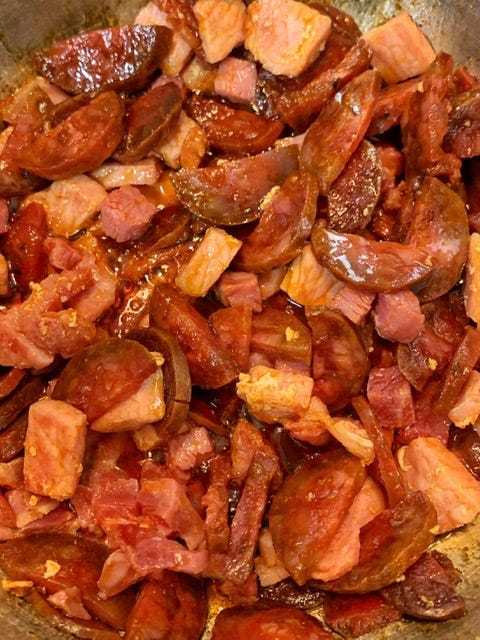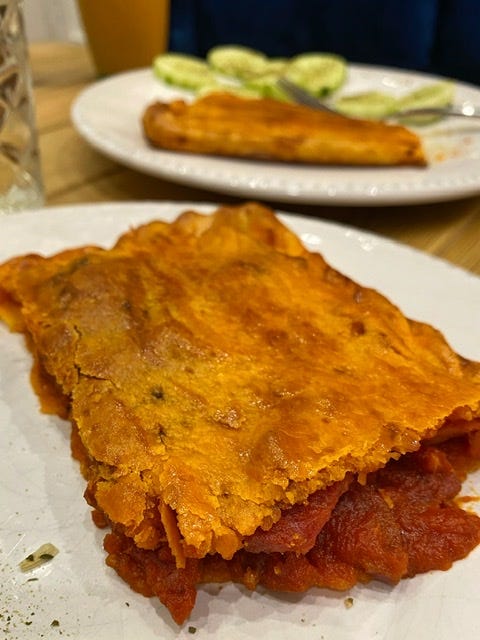Empanada: your new favorite weeknight dinner
Or as my nephew likes to call it, Spanish pizza sandwich. Recipe inside!
A few weeks ago some of my family came to visit us in Madrid. One of my favorite things in life is to show people around where I live. I felt the same back in Chicago; whether it’s taking visitors to notable architectural sites or my favorite neighborhood haunt, I just like sharing a slice of my life with friends and family (a huge driver of my motivation to write this newsletter, now that I think of it!).
While the US is vast and culture varies from coast to coast (and state to state, or city to city even), you can pretty much get a taste of the different regional cuisines no matter where you are. Barbecue may not be as specialized in the Pacific Northwest as in North Carolina, but I can guarantee that the good people of Idaho have had a decent pulled pork sandwich.
What makes having visitors in Spain so special is that most of the time people haven’t tried the foods here in their entire lifetime. If you live in a bigger city in the US, you can probably find a Spanish tapas restaurant, but even then you’re most likely only going to try the most famous of Spanish cuisine: tortilla de patata, gazpacho, maybe some decent jamón ibérico if you’re lucky.
This time around my elementary-aged nephews were among our guests. Leading up to their visit, David and I brainstormed what foods they may like, and what to have around the house. While Spanish food isn’t spicy, the flavor profile can be strong for some foods—David says that even young kids in Spain don’t typically like jamón at first (My nephews, on the other hand, were to be immediate super fans. Go figure.). What was something decidedly Spanish, yet with somewhat recognizable flavors, kid-friendly, and easy to throw together after a long day of walking tourism?
Enter the empanada.
The Real Academia Española defines empanada as a bread dough filled with meat, fish, vegetables, etc that is baked in the oven. To go a bit deeper into the linguistics of it, empanar means either to wrap something in dough or bread before baking, or to roll a food in breadcrumbs before frying it. If we break the word down, pan means bread, and em- is sort of like the prefix in- that we find in English, so the word is quite logical and straightforward: empanar is to put something in bread (or dough). Linguistics lesson complete.
In Spain, empanada (the noun) refers to a specific dish that is popular in Galicia, a province in Northern Spain, but is eaten all over the country. The dish is made with two sheets of dough—typically rectangular—and a filling spread in between the two layers. Think a large, rectangular calzone. Or, as my oldest nephew christened it, a “Spanish pizza sandwich.” I can think of no better description.
Empanada can have various fillings, including tuna, ground beef, or even scallops. There’s usually a common base of either tomato sauce or more of a sofrito that’s made with onion, garlic, green or red pepper, and tomato. My favorite filling by far consists of chunks of chorizo, pork in adobo sauce, and tiny bits of jamón mixed with tomato sauce. The blend of flavors really does resemble pizza, minus the cheese.
The nice thing about empanada is that it’s fairly quick to make, and it’s forgiving. You can eat it hot out of the oven, but it’s just as delicious at room temperature. As David’s mom says, it makes for a cena cómoda1 for when people come over, and it can easily be made ahead. You could make the dough from scratch, but grocery stores here offer a wide variety of refrigerated pre-made doughs that make life much more simple and are still delicious.
For anyone wanting to give it a try, I’m leaving our house recipe below. For my friends outside of Spain, it may be a bit tricky to find the exact dough needed. One option could be trying puff pastry or pie dough—although neither dough is exactly the same as empanada—or trying your hand at making it yourself. As I’ve never made it from scratch, I can’t vouch for any particular recipe, but Google returns several hits if you’re feeling brave. My other wild-card idea is using the equivalent weight of Goya empanada dough and rolling it out into two rectangles for the Spanish empanada format. Choose your own adventure!

Empanada de chorizo, lomo adobado, y jamón
Yield: 8-12 servings
Special equipment needed
Baking sheet
Parchment paper
Rolling pin
Cutting board (optional, as surface for rolling dough)
Fork for poking holes in dough
Pastry brush for egg wash
Ingredients
2 sheets of empanada dough, 280g each
1 tbsp olive oil
230g pork loin in adobo, cut into small pieces (it’s okay if you can’t find it in adobo; you can use regular pork loin as-is, or with a bit of added paprika and garlic)
270g chorizo, cut into half- or quarter-slices
100g tiny chunks of jamón (if you can’t find it, small chunks of prosciutto should work)
Approximately 450g tomato sauce (as in the kind you would use for pasta, not natural tomato)2
1 tsp granulated sugar
1 egg
Flour for sprinkling on counter/cutting board
Directions
For filling:
Preheat oven to 210°C/410°F, with convection if you have it. Move oven rack to position second from the bottom (so if your oven has five positions, move it to the fourth from the top).
Heat olive oil in pan over medium-high heat and add pork. Fry until some pieces start to golden, then remove pork from pan.
Add chorizo to pan containing the remaining oil/grease from the pork. Fry for 2-3 minutes.
Stir in jamón and cook briefly (1-2 minutes), being careful to not dry it out.
Add pork back into pan (all three meat types should now be in the pan), stir to combine, then remove pan from heat.
Strain grease/oil mixture into a small bowl, leaving the meat in the pan.
Pour tomato sauce into pan with the meat. You can add a bit more sauce if needed; the mixture should be saucy without reaching the point of soupy.
Stir in sugar, a bit of the leftover oil mixture to taste (approx 1/2-1 tbsp is our usual), and put back on the stove to cook for 3 more minutes.
Remove mixture and let cool.
To assemble:
Extend first layer of dough over a floured surface (countertop or cutting board, your choice) and roll dough to match size of baking sheet.
Cover baking sheet in parchment paper then carefully place dough on top.
Spoon filling onto the dough and extend, leaving 1-2 cm edges.
Roll out second layer of dough as instructed above, then gently place on top of filling.
Form the edges/crust of the empanada by pinching the edges of the dough together and twisting inward (see picture above). Press firmly to make sure that the edges are closed well.
Use fork to poke holes in top layer of dough.
Lightly beat egg in a small bowl, then use pastry brush to extend egg wash over top of dough and edges. Brush slightly under the edges as well (this helps with sticking).
Bake approximately 30 minutes, or as directed on dough package. I suggest checking the empanada after 20-25 minutes have passed. It’s done when it’s a nice golden color.
Remove empanada from oven and let cool before slicing.
You can choose how small or large to cut the empanada slices; as I mention in the yield above, we usually cut it into 8-12 pieces. Everyone knows that the best part of empanada is the edge, so your guests will love you if you manage to include a bit of crust on each slice.
This particular empanada is quite heavy, considering all of the different meats. I would suggest serving it with a crisp side salad, some raw veggies, or a large, ripe tomato sliced into wedges and drizzled with a bit of olive oil and salt. If you want to lean further into Spanish culture, gazpacho and other cold soups would be good options. You could also cut the empanada into smaller slices and serve it as an appetizer.
An interesting tidbit about the word empanado/a before you go: it can also be used colloquially to mean a person who is distracted or zoned-out. I’m sure there’s a pun to be had here, but I’ve made myself hungry with all of this food talk and can’t think of one.
Another quick note: this week’s Sunday Sobremesa is up and we’re talking about fall foods we’re looking forward to eating! You can click over using this link, or the current sobremesa is always pinned to the homepage of the newsletter.
If you try out the recipe (or have any questions), please let me know! Also this type of cuisine—bread stuffed with dough—is typical all across the world, so let us know your local version or favorite type in the comments below!
Until next time,
Ki
Cena cómoda: Literally “comfortable dinner,” meaning an easy, convenient meal to make
Note on the tomato sauce: The kind we get here has tomato, olive oil, sugar, salt, and “spices” if you want to look for something similar.







First of all, pies and autumn? Yes please. I'm so excited about going back to baking Kiki and I know from previous conversations that we share the same excitement 😁
I'd love to try and making a veg empanada from scratch, if you can recommend a recipe for the dough I'd be most grateful.
In return, here are 2 autumn pies I shared last year, they are the most heartwarming and comforting kind of savory pie, nicely wrapped up in dough, just like empanada.
https://sinufogarizzu.substack.com/p/train-notes
It sounds delicious! I think I might try this!❤️